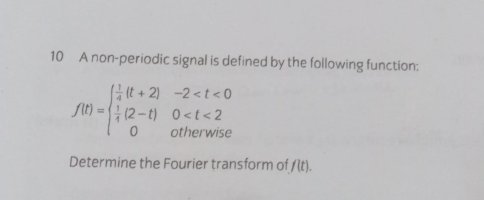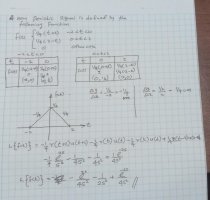You are using an out of date browser. It may not display this or other websites correctly.
You should upgrade or use an alternative browser.
You should upgrade or use an alternative browser.
Periodic signal to Laplace Transform
- Thread starter PA3040D
- Start date
Can you please tell me how Laplace transform is defined in your book? You can tell me the definition or the theorem, any one of them will help me know what you are trying to find.
Since I don't know what is going on, I will make guesses!
First Guess.
The Laplace transform that I know is defined on [imath]t \geq 0[/imath]. Therefore, do you want to repeat the right half of the triangle periodically, or do you want to shift the whole triangle to the positive domain and then repeat it periodically? After that we can find the Laplace transform for that periodic signal.
Second Guess.
The triangle in the picture is not periodic. Do you want to find the Laplace transform of the right half for [imath]0 \leq t \leq 2[/imath]? Or do you want to shift the whole triangle to the positive domain, so we have [imath]0 \leq t \leq 4[/imath], and then we can find the Laplace transform of that triangle (signal)?
Since I don't know what is going on, I will make guesses!
First Guess.
The Laplace transform that I know is defined on [imath]t \geq 0[/imath]. Therefore, do you want to repeat the right half of the triangle periodically, or do you want to shift the whole triangle to the positive domain and then repeat it periodically? After that we can find the Laplace transform for that periodic signal.
Second Guess.
The triangle in the picture is not periodic. Do you want to find the Laplace transform of the right half for [imath]0 \leq t \leq 2[/imath]? Or do you want to shift the whole triangle to the positive domain, so we have [imath]0 \leq t \leq 4[/imath], and then we can find the Laplace transform of that triangle (signal)?
Last edited:
Dear sir, I sincerely apologize for not mentioning this at the top. Originally, the question requested determine the Fourier transform. However, to enhance my understanding, I opted to illustrate the signal and convert it to Laplace transform, as I am currently studying Laplace Transform theory. I regret any inconvenience this may have caused.
Note
Since they don't provide reference books, I'm relying on YouTube videos for my studies. However, there's a risk of going astray. I would greatly appreciate it if you could have enough time to correct me and share your knowledge. Your guidance would be immensely valuable to me
Original Question is

Note
Since they don't provide reference books, I'm relying on YouTube videos for my studies. However, there's a risk of going astray. I would greatly appreciate it if you could have enough time to correct me and share your knowledge. Your guidance would be immensely valuable to me
Original Question is

Now the graph makes sense and the rules of the game are on our hands. To find the Fourier transform of that function, you have to consider two cases:
Case 1: [imath] \ \ \ \omega \neq 0[/imath]
[imath]\displaystyle \mathcal{F}\{f(t)\} = \frac{1}{2\pi} \int_{-\infty}^{\infty}f(t) \ e^{i\omega t}\ dt[/imath]
Case 2: [imath] \ \ \ \omega = 0[/imath]
[imath]\displaystyle \mathcal{F}\{f(t)\} = \frac{1}{2\pi} \int_{-\infty}^{\infty}f(t) \ dt[/imath]
Unlike the Laplace transform, the calculations in the Fourier transform are longer and need more attention!
Note: Some authors use [imath]\displaystyle \frac{1}{2\pi}[/imath] with the inverse Fourier transform, other authors even use [imath]\displaystyle e^{i\omega t}[/imath] for the inverse Fourier transform. It does not matter much which notation you will use as along as you will be consistent with the two transforms (Fourier transform and Inverse Fourier transform). For a precise Fourier transform notation, follow your book definition.
Case 1: [imath] \ \ \ \omega \neq 0[/imath]
[imath]\displaystyle \mathcal{F}\{f(t)\} = \frac{1}{2\pi} \int_{-\infty}^{\infty}f(t) \ e^{i\omega t}\ dt[/imath]
Case 2: [imath] \ \ \ \omega = 0[/imath]
[imath]\displaystyle \mathcal{F}\{f(t)\} = \frac{1}{2\pi} \int_{-\infty}^{\infty}f(t) \ dt[/imath]
Unlike the Laplace transform, the calculations in the Fourier transform are longer and need more attention!
Note: Some authors use [imath]\displaystyle \frac{1}{2\pi}[/imath] with the inverse Fourier transform, other authors even use [imath]\displaystyle e^{i\omega t}[/imath] for the inverse Fourier transform. It does not matter much which notation you will use as along as you will be consistent with the two transforms (Fourier transform and Inverse Fourier transform). For a precise Fourier transform notation, follow your book definition.
Now the graph makes sense and the rules of the game are on our hands. To find the Fourier transform of that function, you have to consider two cases:
Case 1: [imath] \ \ \ \omega \neq 0[/imath]
[imath]\displaystyle \mathcal{F}\{f(t)\} = \frac{1}{2\pi} \int_{-\infty}^{\infty}f(t) \ e^{i\omega t}\ dt[/imath]
Case 2: [imath] \ \ \ \omega = 0[/imath]
[imath]\displaystyle \mathcal{F}\{f(t)\} = \frac{1}{2\pi} \int_{-\infty}^{\infty}f(t) \ dt[/imath]
Unlike the Laplace transform, the calculations in the Fourier transform are longer and need more attention!
Note: Some authors use [imath]\displaystyle \frac{1}{2\pi}[/imath] with the inverse Fourier transform, other authors even use [imath]\displaystyle e^{i\omega t}[/imath] for the inverse Fourier transform. It does not matter much which notation you will use as along as you will be consistent with the two transforms (Fourier transform and Inverse Fourier transform). For a precise Fourier transform notation, follow your book definition.
This is what they have been provided. I am still confuse what formula to be used for Fourier transform and Inverse Fourier transform

Use what they have given you.
For the Fourier transform, use:
[imath]\displaystyle \mathcal{F}\{f(t)\} = \widehat{f}(\omega) = \int_{-\infty}^{\infty}f(t) \ e^{-i\omega t}\ dt[/imath]
For the Inverse Fourier transform, use:
[imath]\displaystyle \mathcal{F}^{-1}\{\hat{f}(\omega)\} = f(t) = \frac{1}{2\pi}\int_{-\infty}^{\infty}\hat{f}(\omega) \ e^{i\omega t}\ d\omega[/imath]
For the Fourier transform, use:
[imath]\displaystyle \mathcal{F}\{f(t)\} = \widehat{f}(\omega) = \int_{-\infty}^{\infty}f(t) \ e^{-i\omega t}\ dt[/imath]
For the Inverse Fourier transform, use:
[imath]\displaystyle \mathcal{F}^{-1}\{\hat{f}(\omega)\} = f(t) = \frac{1}{2\pi}\int_{-\infty}^{\infty}\hat{f}(\omega) \ e^{i\omega t}\ d\omega[/imath]

